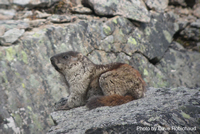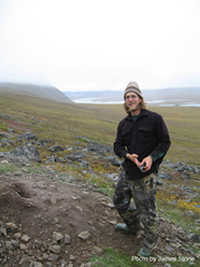Alaska marmots trump reality TV
Alaska marmots trump reality TV
Submitted by Ned Rozell
Phone: 907-474-7468
01/23/08


One million dollars or a summer in the hills chasing Alaska marmots? Not many people have to make this choice, but Aren Gunderson is not like most people.
Gunderson, 27, lives in Fairbanks, in a cabin with no running water. He is tall, athletic, adventurous, and probably would do well on the reality television show Survivor, where contestants test their tenacity and social skills on a tropical island. The last person standing gets $1 million.
Upon the urging of his sister, Rane Cortez of Washington D.C., Gunderson, a student working on a master’s degree from the University of Alaska Fairbanks, made an audition video for the producers of Survivor. In his three-minute film, the shaggy-haired Gunderson is seen dog mushing and, with his snow-covered outhouse as a backdrop, ranting as to why he needs a million dollars.
He mailed the tape to Seattle and went on with his life as an Alaska graduate student who wears Carhartts and does fieldwork in some of the most incredible alpine country on Earth.
A few months later came a surprise call from a casting agent-Survivor wanted him. The commitment was three months, including 60 days of sequestering in an unknown location if he left the island early. The opportunity caught him a bit off-guard.
"I was in a spot," he said.
The problem was that Gunderson studies the mysterious Alaska marmot, a creature the size of a chubby house cat that haunts Alaska mountaintops in the Brooks Range and a few other spots north of the Yukon River. Survivor wanted him mid-June to mid-August. Alaska marmots hibernate for nine months; the only time they show themselves is from June to September.
"It was definitely a dilemma," he said. "I had to decide whether to forgo my thesis for a season or not."
After a tortuous week in March, Gunderson wondered a thousand times whether he should sign the Survivor contract and FedEx it back to the producers. He decided to go with the marmots.
"I just couldn’t put the previous three years aside for a chance to be on TV," he said.
His academic advisor, Link Olson, the curator of mammals at the University of Alaska Museum of the North, thought Gunderson made the right call. The Alaska Department of Fish and Game’s Nongame Program had funded Gunderson’s thesis program, and the grant would have expired before his final field season had he chosen to be on the show.
Survivor’s loss was the Alaska marmot’s gain. Gunderson finished his master’s thesis on the Alaska marmot, called "the most handsome of American marmots" in 1934 by two of the first people to study them. Marmots come in three varieties in Alaska-the hoary, which whistle from rock outcroppings in the high country south of the Yukon River; the woodchuck, found in agricultural areas near roads; and the Alaska, one of only three mammals found nowhere else but the Alaska mainland (the other two are the arctic hare and the Glacier Bay water shrew).
Before Gunderson’s thesis work, the world knew little about Alaska marmots, which are confined to the Brooks Range and small patches of the Ray Mountains and the Kokrines Hills. They are dependent on the high country, which may be changing in a warming climate.
"What polar bears are to sea ice, marmots are to alpine ecosystems," Gunderson said.
Gunderson was able to draw the first reliable range map for the Alaska marmot, using the new ancient DNA lab at the University of Alaska Museum of the North. Gunderson used marmots that he, Olson, and others collected, in addition to specimens from the UA Museum and others.
"Just about everything we observed about them was new (to science)," he said. "For a large, fairly conspicuous mammal to be so unknown is pretty remarkable," he said.
With his degree in his back pocket, Gunderson said he had no regrets about choosing marmots over the chance to become instantly wealthy.
"I definitely made the right choice," he said.
This column is provided as a public service by the Geophysical Institute, University of Alaska Fairbanks, in cooperation with the UAF research community. Ned Rozell is a science writer at the institute. To view past columns or to subscribe, visit www.gi.alaska.edu/ScienceForum/index.html.


